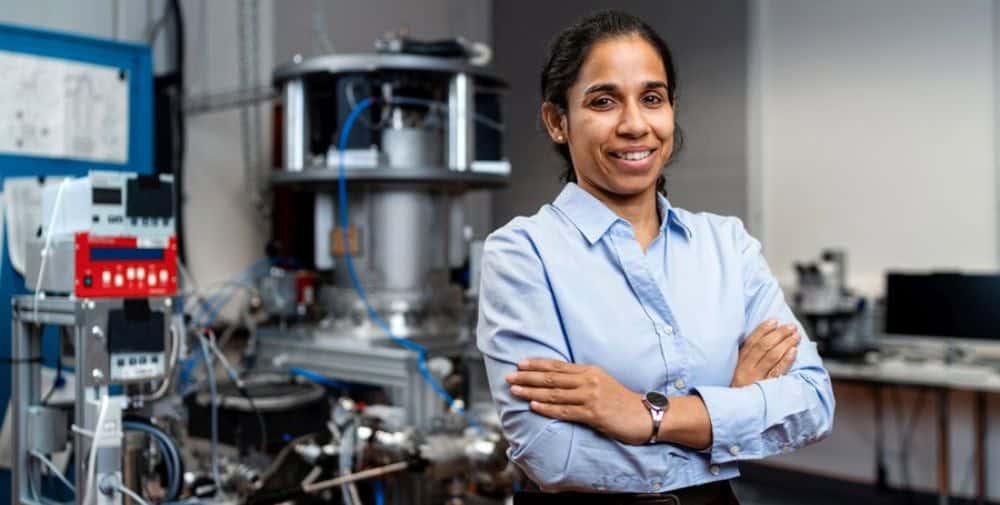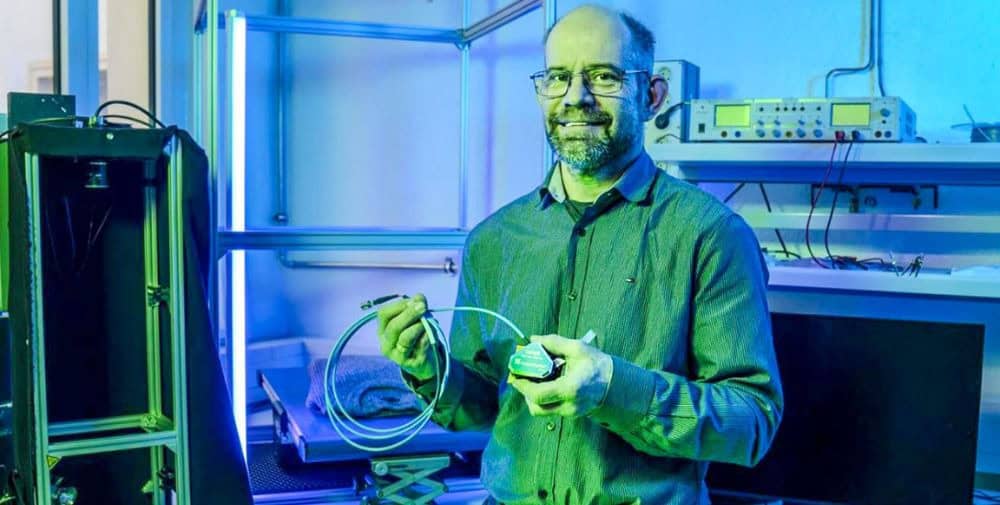Intralogistics refers to all the logistical processes that take place on a company’s premises. What are the current software challenges in this area?
Heike Wilson: I see two major challenges here. Particularly in small and medium-sized companies, there are still a lot of isolated solutions, all tailor-made and custom-fit for the respective logistics process. This starts with goods receipt and continues through quality inspection to the processing of a picking order, which is often still triggered manually today to supply production with materials. Data is generated everywhere, often still in local data silos.
Eliminating these data silos and merging local solutions on a single platform is the first major challenge.
Because only then will holistic and superordinate process control, monitoring, and analysis become possible in intralogistics in the first place. And then we come to the next challenge. In logistics today, a great deal is still done manually and on demand. I believe that in the future, much more planning will have to be automated and system-controlled in order to be able to respond directly in real time to changes in material requirements from production or simply to changes in the general conditions, such as quality inspection.
Here, automated planning approaches also reduce the amount of training required, which counteracts the growing shortage of skilled workers.
Processes and concepts from production optimization, such as APS (Advanced Planning and Scheduling) systems, could be transferred to intralogistics processes here. This saves time and resources and ultimately brings the next efficiency gain.
How are these expanding as a result of the ever more extensive automation of production processes?
Heike Wilson: The production concepts of the future are becoming more and more flexible, which in my opinion also requires ever greater flexibility in internal logistics. For material supply in these concepts, companies are currently considering expanding their conventional forklift supply with automated guided vehicles (AGV). In this area, there are now a large number of interesting suppliers of automation solutions that include both hardware and software solutions in a bundle. However, this also increases the complexity of logistics processes and their control. And, of course, significant initial investments have to be made before the benefits materialize. Against this background, the design question of such logistics concepts is becoming increasingly important. At this point, the planning and engineering phase can be supported by material flow simulations. The planned concepts, in greenfield or more frequently brownfield, are then visualized and simulated in 3D in advance.
On the basis of the analyses, important findings and further optimization potential often arise with regard to the planned material flow, required logistics areas such as the design of storage types and intermediate buffers, the number of transport systems or, in principle, for transport route optimization between logistics and production.
If the simulation models are then extended to include the control logic, for example, virtual plant commissioning becomes possible, which in turn can enormously reduce the times on the construction site and can be used operationally for global logistics control. In practical terms, we are then on the way to a digital twin of the logistics facility, which in turn can be the basis for many very useful applications in the future, in which algorithms can then detect anomalies in the process in advance. So the challenges continue to grow, but there are also already very good applications that we as software experts can bring into use together with SMEs.
What advantages do intelligent algorithms and machine learning offer and where are they already being used in intralogistics today?
Heike Wilson: Intelligent algorithms have already been used successfully in production optimization and detailed order planning for several years, especially in planning and control solutions. And the first steps have already been taken in machine learning as well. Especially against the backdrop of ChatGPT, there has been a lot of discussion in recent weeks about the extent to which AI technologies can also be used in industry. I think the success and benefit will depend very much on how well the models, e.g. also in intralogistics, can be trained for the use of machine learning. For our production planning software GANTTPLAN APS, we are currently in the process of testing the use of machine learning as a prototype add-in in a funded project.
As with the previous use of mathematical algorithms in production and order planning, the data quality of machine learning is also a decisive factor in the output of the calculation, and this will not change with AI.
But I am convinced that both, when used continuously, also offer considerable advantages in intralogistics for a wide variety of issues. Algorithms can minimize errors in logistics by automatically monitoring inventories, for example, and triggering reorders in good time to avoid production stoppages. Machine learning could quickly detect changes in the logistics process, react to anomalies and automatically adjust processes in this regard or offer the user options for action. Today, intelligent calculations based on mathematical algorithms and/or heuristics are already used in many warehouse management programs or ERP systems with logistics modules. For example, warehouse management systems in automated high-bay warehouses can already monitor stock levels in real time and send optimized orders to ERP software. And all this without any manual intervention.
Intelligent route optimization is already being used in the picking of goods to optimize routes and pick time when processing orders. The employees in these areas are efficiently supported by these applications and processes in order processing are significantly accelerated as a result.
Central control algorithms that process important information from the production stations in real time are also already being used today in the aforementioned transport automation by means of driverless transport systems (AGV). For example, the route planning of the individual AGVs can be changed automatically based on these ad-hoc messages, or the battery consumption of the hardware can be optimized depending on the forecast order volume.
Overall, intelligent algorithms and machine learning offer numerous advantages in intralogistics and will play an increasingly important role in the future.
SMEs often have limited financial and human resources. Are they therefore less able to identify which software solutions help to map processes in a more cost-effective and resource-efficient way?
Heike Wilson: That is indeed a very important question. Large industrial companies are often cited as prime examples for optimization and digitization approaches in production and logistics, which are supposedly thoroughly digitized with major investments. However, the question of the right software for SMEs often takes center stage. I always advise our customers, most of whom are also manufacturing SMEs, not to let themselves be driven crazy and rather to orient themselves to best practice examples in their own industry. There are also enough professional exchange formats, e.g. in Silicon Saxony e.V., comprehensive training opportunities, public funding programs for digitization measures – launched regionally by the SAB, for example, and various Industry 4.0 networks that are open to everyone and from which you can get important information and support for your own digitization strategy.
I don’t think there’s any question these days that digitization is becoming increasingly important, especially for SMEs, but software always has to be used in the right place with the right people. And almost always, a software solution also requires cross-departmental change.
But the most important thing for a successful software selection and implementation is to analyze one’s own processes and identify the most important “pain points”. From this, you can then use a company-specific maturity analysis to transfer the priorities for individual digitization steps into your own roadmap, which is then supported over time with available capacities and financial resources. This ensures that SMEs in particular invest in the right place and move forward in a step-by-step and targeted manner.
If we take a look into the future: What will be the challenges for software in the next five years?
Heike Wilson: The challenges will be many and varied.
For me, looking into the crystal ball today reveals four major fields of action for future software solutions: Expansion of automation and robotics, further optimization potential of warehouse and transport systems, improvement of data input and analysis, and the topic of cyber security.
The further integration of robotics and automation is essential for high productivity in Germany. Against the backdrop of an even worsening shortage of skilled workers, software must be able to autonomously control and coordinate a wide variety of systems in the future to ensure smooth production and logistics operations. It is becoming increasingly difficult to find qualified employees who are capable of looking after and maintaining complex systems. Automation can be a solution here to reduce dependence on skilled workers. However, the software must be designed in such a way that it can be quickly learned and operated by less qualified employees.
Point two is the further optimization of warehouse and transport processes. The aim here is to design processes in such a way that they are as efficient, resource-saving and cost-effective as possible. The software must be able to collect data from all processes, link them and analyze them quickly in order to then identify optimization potential for the individual operator, if possible in real time, and show possible solution scenarios, both in strategic and operational applications.
Voice and gesture-supported control of assistance systems or the actual hardware itself will also be a growing area for future software solutions in my view. Voice support could make data collection more direct, and integrating interaction or gestures will additionally reduce input time. And, of course, data collection and analysis will change. As mentioned at the beginning, data from different sources and applications will be linked together. This in turn leads to being able to make better decisions in complex systems. But of course, we no longer do this manually; instead, we are supported in this by machine learning methods that are deeply integrated into the software applications.
And last but not least, the whole issue of ensuring cyber security plays a very important role. Increasing networking and automation pose risks here that must be minimized. Software must be able to protect systems and detect and defend against attacks. I would be very pleased if we could successfully meet the major challenges of the next few years in this way, even if one or two of the points in my software vision may not come to pass for another 10 years. But I expect these future trends, to which the DUALIS team will also contribute, to lead to sustainable and efficient work in the factories of the future!
Thank you so much for the interview, Heike Wilson.
_ _ _ _ _
Our interview partner

Heike Wilson
Managing Director DUALIS GmbH IT Solution
E-mail: hwilson@dualis-it.de
Phone: +49 351 47791-620
👉 LinkedIn
_ _ _ _ _
DUALIS GmbH IT Solution
Founded in 1990, DUALIS GmbH IT Solution, a subsidiary of iTAC Software AG, specializes in the development of software and services for planning, simulation and optimization of production and factories.
The Industrie 4.0-compliant solutions from DUALIS support companies in operating smart factories efficiently and achieving a high level of planning, practical and investment security as well as permanent cost optimization.
The product range includes the detailed planning tool GANTTPLAN APS for production planning, the software AREAPLAN for efficient scheduling of assembly projects in the factory and the 3D simulation platform Visual Components for factory and robot simulation. The products are integrated in numerous applications in large-scale industry and in medium-sized companies in the production and service sectors.
Breitscheidstraße 36 I D-01237 Dresden
Phone: +49 (0) 351-47791-0
Fax: +49 (0) 351-47791-99
E-mail: dualis@dualis-it.de
👉 To the company website




